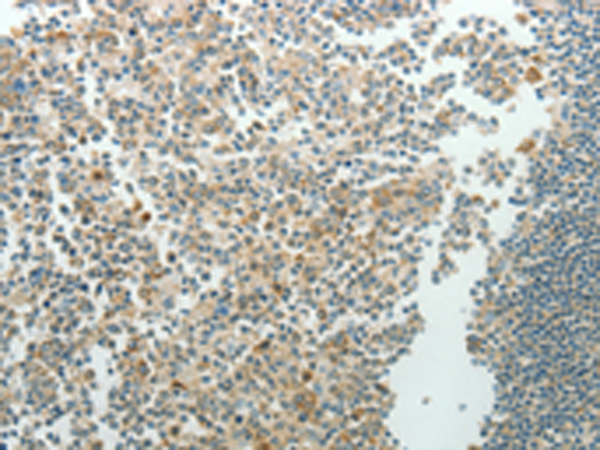


| WB | 咨询技术 | Human,Mouse,Rat |
| IF | 咨询技术 | Human,Mouse,Rat |
| IHC | 1/100-1/300 | Human,Mouse,Rat |
| ICC | 技术咨询 | Human,Mouse,Rat |
| FCM | 咨询技术 | Human,Mouse,Rat |
| Elisa | 1/2000-1/10000 | Human,Mouse,Rat |
| WB Predicted band size | 41 kDa |
| Host/Isotype | Rabbit IgG |
| Antibody Type | Primary antibody |
| Storage | Store at 4°C short term. Aliquot and store at -20°C long term. Avoid freeze/thaw cycles. |
| Species Reactivity | Human, Mouse, Rat |
| Immunogen | Synthetic peptide of human NDRG3 |
| Formulation | Purified antibody in PBS with 0.05% sodium azide and 50% glycerol. |
+ +
以下是关于NDRG3抗体的3篇参考文献,按文献名称、作者及摘要内容简要概括:
---
1. **文献名称**:*NDRG3 Drives Hepatocellular Carcinoma Progression by Promoting HIF-1α-Mediated Angiogenesis*
**作者**:Chen L, et al.
**摘要**:研究利用NDRG3特异性抗体(Western blot和免疫组化)证实其在肝癌中高表达,并通过调控HIF-1α通路促进血管生成,提示其作为潜在治疗靶点。
2. **文献名称**:*Development of a Polyclonal Antibody Against Human NDRG3 for Immunohistochemical Analysis in Breast Cancer*
**作者**:Sato R, et al.
**摘要**:报道了一种自制NDRG3多克隆抗体的开发与验证,通过免疫组化检测乳腺癌组织中NDRG3表达,发现其与患者预后呈负相关。
3. **文献名称**:*NDRG3 Modulates Cellular Stress Response through Interaction with the mTORC1 Pathway*
**作者**:Park S, et al.
**摘要**:使用NDRG3抗体进行免疫沉淀和免疫荧光实验,揭示NDRG3在营养胁迫下通过mTORC1通路调控细胞代谢和存活机制。
---
以上文献均明确涉及NDRG3抗体的实验应用(如Western blot、免疫组化、免疫沉淀等),涵盖癌症机制、抗体开发及信号通路研究。如需具体DOI或年份,可进一步补充。
The NDRG3 (N-myc downstream-regulated gene 3) antibody is a tool used to study the protein encoded by the NDRG3 gene, part of the NDRG family involved in cellular stress responses, differentiation, and cancer progression. NDRG3 is hypoxia-inducible and interacts with signaling pathways like HIF-1α and Ras, playing roles in tumor growth, metastasis, and angiogenesis. It is implicated in cancers such as prostate cancer, glioblastoma, and hepatocellular carcinoma, where its expression often correlates with aggressiveness.
NDRG3 antibodies are typically developed in rabbits or mice using immunogenic peptide sequences from conserved regions of the protein. These antibodies enable detection of NDRG3 via techniques like Western blot, immunohistochemistry (IHC), and immunofluorescence (IF). Specificity is validated using knockout controls or siRNA knockdowns. Researchers use these antibodies to explore NDRG3’s role in hypoxia adaptation, metabolic reprogramming, and its dual functions as a tumor promoter or suppressor, depending on context.
Challenges include cross-reactivity with other NDRG family members (e.g., NDRG1/2) and post-translational modifications (e.g., phosphorylation) that may affect antibody binding. Proper validation and optimization are critical for reliable results. NDRG3 antibodies thus serve as key reagents in cancer biology and hypoxia-related research.
×